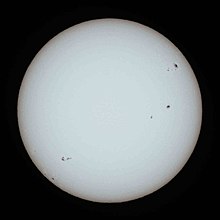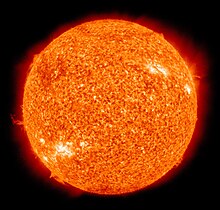
Back Амра Abkhazian Mata uroe ACE Тыгъэ ADY Son Afrikaans Sonne ALS ፀሐይ Amharic Cidal AMI Sol AN Sunne ANG Ura ANN
 Poto ring sunar kacingak manut saking filter surya ring warsa 2013 sané wénten titik surya miwah limb darkening. | |
 False-color potret kapotret ring warsa 2010 sané anggén cahaya ultraviolet (gelombang cahaya 30.4 nm) | |
| Data observasi | |
|---|---|
| Mean distance from Earth | 1 au ≈ 1.496×108 km[1] 8 min 19 s at light speed |
| Visual brightness (V) | −26.74[2] |
| Absolute magnitude | 4.83[2] |
| Spectral classification | G2V[3] |
| Metallicity | Z = 0.0122[4] |
| Angular size | 31.6–32.7 minutes of arc[5] |
| Adjectives | Solar |
| Orbital characteristics | |
| Mean distance from Milky Way core | ≈ 2.7×1017 km 27,200 light-years |
| Galactic period | (2.25–2.50)×108 yr |
| Velocity | ≈ 220 km/s (orbit around the center of the Milky Way) ≈ 20 km/s (relative to average velocity of other stars in stellar neighborhood) ≈ 370 km/s[6] (relative to the cosmic microwave background) |
| Physical characteristics | |
| Equatorial radius | 695,700 km,[7] 696,342 km[8] 109 × Earth[9] |
| Equatorial circumference | 4.379×106 km[9] 109 × Earth[9] |
| Flattening | 9×10−6 |
| Area permukaan | 6.09×1012 km2[9] 12,000 × Earth[9] |
| Volume | 1.41×1018 km3[9] 1,300,000 × Earth |
| Massa | 1.9884×1030 kg[2] 333,000 × Earth[2] |
| Average density | 1.408 g/cm3[2][9][10] 0.255 × Earth[2][9] |
| Center density (modeled) | 162.2 g/cm3[2] 12.4 × Earth |
| Equatorial surface gravity | 274 m/s2[2] 28 × Earth[9] |
| Moment of inertia factor | 0.070[2] (estimate) |
| Escape velocity (from the surface) | 617.7 km/s[9] 55 × Earth[9] |
| Suhu | Center (modeled): 1.57×107 K[2] Photosphere (effective): 5,772 K[2] Corona: ≈ 5×106 K |
| Luminosity (Lsol) | 3.828×1026 W[2] ≈ 3.75×1028 lm ≈ 98 lm/W efficacy |
| Color (B-V) | 0.63 |
| Mean radiance (Isol) | 2.009×107 W·m−2·sr−1 |
| Age | ≈ 4.6 billion years[11][12] |
| Karakteristik rotasi | |
| Obliquity | 7.25°[2] (to the ecliptic) 67.23° (to the galactic plane) |
| Right ascension of North pole[13] | 286.13° 19 h 4 min 30 s |
| Declination of North pole | +63.87° 63° 52' North |
| Sidereal rotation period (at equator) | 25.05 d[2] |
| (at 16° latitude) | 25.38 d[2] 25 d 9 h 7 min 12 s[13] |
| (ring kutub) | 34.4 d[2] |
| Kecepatan rotasi (ring ekuator) | 7.189×103 km/h[9] |
| Komposisi Photospheric (manut massa) | |
| Hidrogén | 73.46%[14] |
| Hélium | 24.85% |
| Oksigén | 0.77% |
| Karbon | 0.29% |
| Wesi | 0.16% |
| Néon | 0.12% |
| Nitrogén | 0.09% |
| Silikon | 0.07% |
| Magnésium | 0.05% |
| Urirang | 0.04% |
Surya (simbol: ![]() ; Indonésia: Matahari, Inggris: Sun) ento bintang ané matongos di tengah tata surya, 1.496×108 km uli Gumi. Gobanné bunter[15] tur bentangné 1.392.684 km, kuang-lebih ping 109 bentang Guminé. Massané kuang-lebih 2×1030 kilogram, 330.000 ping massa Guminé. Surya malakar aji campuhan ané maadan "plasma"[16] ané malakar aji hidrogén (73%), hélium (25%), ajak oksigén, karbon, néon muah besi abedik.[17]
; Indonésia: Matahari, Inggris: Sun) ento bintang ané matongos di tengah tata surya, 1.496×108 km uli Gumi. Gobanné bunter[15] tur bentangné 1.392.684 km, kuang-lebih ping 109 bentang Guminé. Massané kuang-lebih 2×1030 kilogram, 330.000 ping massa Guminé. Surya malakar aji campuhan ané maadan "plasma"[16] ané malakar aji hidrogén (73%), hélium (25%), ajak oksigén, karbon, néon muah besi abedik.[17]
- ↑ Pitjeva, E. V.; Standish, E. M. (2009). "Proposals for the masses of the three largest asteroids, the Moon–Earth mass ratio and the Astronomical Unit". Celestial Mechanics and Dynamical Astronomy (ring Inggris). 103 (4): 365–372. doi:10.1007/s10569-009-9203-8. ISSN 1572-9478.
- ↑ 2,00 2,01 2,02 2,03 2,04 2,05 2,06 2,07 2,08 2,09 2,10 2,11 2,12 2,13 2,14 2,15 Williams, D.R. (1 July 2013). "Sun Fact Sheet". NASA Goddard Space Flight Center. Kaarsipin saking versi asli tanggal 15 July 2010. Kaaksés 12 August 2013.
- ↑ Zombeck, Martin V. (1990). Handbook of Space Astronomy and Astrophysics 2nd edition. Cambridge University Press.
- ↑ Asplund, M.; Grevesse, N.; Sauval, A.J. (2006). "The new solar abundances – Part I: the observations". Communications in Asteroseismology. 147: 76–79. Bibcode:2006CoAst.147...76A. doi:10.1553/cia147s76.
- ↑ "Eclipse 99: Frequently Asked Questions". NASA. Kaarsipin saking versi asli tanggal 27 May 2010. Kaaksés 24 October 2010.
- ↑ Hinshaw, G.; et al. (2009). "Five-year Wilkinson Microwave Anisotropy Probe observations: data processing, sky maps, and basic results". The Astrophysical Journal Supplement Series. 180 (2): 225–245. arXiv:0803.0732. Bibcode:2009ApJS..180..225H. doi:10.1088/0067-0049/180/2/225.
- ↑ Mal:Cite arxiv
- ↑ Emilio, Marcelo; Kuhn, Jeff R.; Bush, Rock I.; Scholl, Isabelle F. (2012), "Measuring the Solar Radius from Space during the 2003 and 2006 Mercury Transits", The Astrophysical Journal, 750 (2): 135, arXiv:1203.4898, Bibcode:2012ApJ...750..135E, doi:10.1088/0004-637X/750/2/135
- ↑ 9,00 9,01 9,02 9,03 9,04 9,05 9,06 9,07 9,08 9,09 9,10 9,11 "Solar System Exploration: Planets: Sun: Facts & Figures". NASA. Kaarsipin saking versi asli tanggal 2 January 2008.
- ↑ Ko, M. (1999). Elert, G. (ed.). "Density of the Sun". The Physics Factbook.
- ↑ Bonanno, A.; Schlattl, H.; Paternò, L. (2002). "The age of the Sun and the relativistic corrections in the EOS". Astronomy and Astrophysics. 390 (3): 1115–1118. arXiv:astro-ph/0204331. Bibcode:2002A&A...390.1115B. doi:10.1051/0004-6361:20020749.CS1 maint: ref=harv (link)
- ↑ Connelly, JN; Bizzarro, M; Krot, AN; Nordlund, Å; Wielandt, D; Ivanova, MA (2 November 2012). "The Absolute Chronology and Thermal Processing of Solids in the Solar Protoplanetary Disk". Science. 338 (6107): 651–655. Bibcode:2012Sci...338..651C. doi:10.1126/science.1226919. PMID 23118187.(Patut kacatet)
- ↑ 13,0 13,1 Seidelmann, P.K.; et al. (2000). "Report Of The IAU/IAG Working Group On Cartographic Coordinates And Rotational Elements Of The Planets And Satellites: 2000". Kaarsipin saking versi asli tanggal 14 May 2019. Kaaksés 22 March 2006.
- ↑ "The Sun's Vital Statistics". Stanford Solar Center. Kaaksés 29 July 2008. Citing Eddy, J. (1979). A New Sun: The Solar Results From Skylab. NASA. p. 37. NASA SP-402. Kaarsipin saking versi asli tanggal 2021-07-30. Kaaksés 2020-02-27.
- ↑ "How Round is the Sun?". NASA. Kaarsipin saking versi asli tanggal 2018-09-17. Kaaksés 2019-06-18.
- ↑ "First Ever STEREO Images of the Entire Sun". NASA. Kaarsipin saking versi asli tanggal 2011-03-08. Kaaksés 2019-06-18.
- ↑ Basu, S.; Antia, H.M. (2008). "Helioseismology and Solar Abundances". Physics Reports. 457 (5–6): 217–283